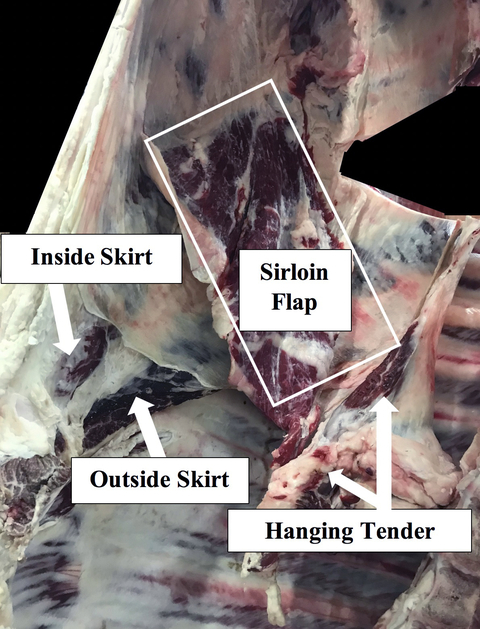Quick facts
Non-traditional, thinner cuts of beef are a great value when cooked right.
- Most cuts benefit from marinating to tenderize.
- Have your butcher remove tough membranes and extra fat before buying.
- Rest meat and cut against the grain for better flavor and easier eating.
Restaurants and steak lovers are cooking and enjoying thinner cuts of beef. Great for grilling and all year round, these lesser-known cuts are delicious and less expensive than the more popular ribeyes and t-bones.
Sirloin flap
Originating from the loin, the bottom sirloin butt flap is located on the inner surface of the bottom sirloin. It has heavy connective tissue and cartilage that should be removed before cooking.
The average weight of a bottom sirloin flap is 8 pounds.
- This steak has a very robust flavor similar to the skirt steak.
- Marinate before cooking to tenderize it, as it is moderately tough.
- Grill on high heat.
- Rest the meat after cooking for 3 to 5 minutes.
- Cut against the grain.
- Great for grilling or pan-broiling.
You may find this cut listed on a restaurant menu as sirloin bavette, bottom sirloin flap or flap meat.
Skirt steak
Originating from the plate (a forequarter cut from the belly of the cow, just below the rib cut), the outside and inside skirt are new favorites with restaurants and master home cooks.
A steer at the average live steer weight of 1,372 pounds should yield 3.34 pounds of outside skirt and 4.21 pounds of inside skirt (USDA-AMS National Daily Cattle & Beef Summary). Together, the skirt steaks comprise almost 8 pounds of beef.
The outside skirt is more in demand, not just because of its smaller volume, but because it is more tender. It will usually be more expensive than the inside skirt. The inside skirt is a working muscle whereas the outside skirt is supportive. These muscles support the diaphragm.
- The skirt steak is a moderately tough piece of meat.
- Remove the peritoneum membrane and trim fat before cooking to reduce toughness.
- Marinate to tenderize.
- Cook on high heat.
- Rest 3 to 5 minutes after cooking to distribute juices.
- Cut against the grain after resting.
- Great for fajitas and Philly Cheese Steak sandwiches.
You’ll find this cut listed on a restaurant menu as skirt steak, fajita steak, Romanian tenderloin or Philadelphia steak.
Hanging tender
Originating from the loin, this muscle attaches the diaphragm to the last rib of the backbone. Once the heavy connective tissue in the center is removed, the resulting cuts are called “pillars.”
- There is only one hanging tender per carcass, about 2.2 pounds from a steer weighing 1,372 pounds.
- This muscle is similar in texture to the skirt steak and has a very rich flavor.
- It should be seasoned, grilled or broiled, and sliced against the grain.
- The retail cut works well as an entrée on its own, as a sliced steak for a salad, or as an appetizer.
You’ll find this cut listed on a restaurant menu as hanger steak, butcher’s steak or bistro steak.
Marinating tips
A marinade is a seasoned liquid used to submerse and tenderize cuts of meat. You can use fruit juices, wine, water or oil combined with seasonings.
To add flavor to meat use a cooked marinade and marinate for two hours.
The enzymes in uncooked marinades tenderize meat. Marinate for at least six hours but not more than 24 hours or meat fibers may break down and become mushy. Follow commercial marinade instructions as they may contain tenderizers in their ingredients such as papain, fresh pineapple or bromelain.
- Marinate meat in the refrigerator at 34 to 38 degrees F.
- Allow 1/4 to 1/2 cup of marinade for 1 to 2 pounds of meat.
- Boil leftover marinade before serving with cooked meat to kill bacteria.
- Never reuse leftover marinade.
- A good marinade should enhance your meat, but not overpower it.
For beef grilling recipes go to Beef.org.
Reviewed in 2023




